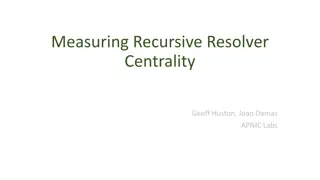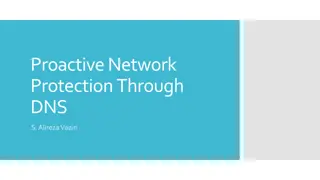Insights into DNS Flag Day 2020 Trends and Analysis
Delve into the DNS Flag Day 2020 observations and trends, including changes in buffer sizes, UDP fragmentation, and the selection of threshold points for DNS to switch to TCP. Explore the impact of varying buffer sizes on users and the DNS system, highlighting shifts in usage percentages and implications for performance optimizations.
Download Presentation

Please find below an Image/Link to download the presentation.
The content on the website is provided AS IS for your information and personal use only. It may not be sold, licensed, or shared on other websites without obtaining consent from the author.If you encounter any issues during the download, it is possible that the publisher has removed the file from their server.
You are allowed to download the files provided on this website for personal or commercial use, subject to the condition that they are used lawfully. All files are the property of their respective owners.
The content on the website is provided AS IS for your information and personal use only. It may not be sold, licensed, or shared on other websites without obtaining consent from the author.
E N D
Presentation Transcript
Measuring DNS Flag Day 2020 Geoff Huston Joao Damas APNIC Labs 1
What Happened? We d like to look at two aspects of this work: What happened on 1 October 2020 (and thereafter) in the DNS? Is that recommended value of 1,232 just right? Too small? Too large? 5
Looking at EDNS(0) Buffer Sizes Jan 2020 August 2020 4,096 used by queries from 80% - 95% of users 512 (no size specified) used by 10% of users Weekday / Weekend profile suggesting a difference between enterprise and access ISP profiles These results are from looking at queries between recursive resolvers and authoritative servers 6
Flag Day 2020 August 2020 December 2020 Use of 4,096 buffer size dropped from ~84% to 70% of users by December Rise in 1,400 buffer size to 8% of users Flag Day 7
UDP Fragmentation EDNS(0) UDP Buffer Size > MTU August 2020 December 2020 Fragmentation avoidance settings rose from 12% of users to ~22% of users Flag Day EDNS(0) UDP Buffer Size < MTU 8
UDP Fragmentation Avoidance Flag Day August 2020 December 2020 1,232 is now used by 5% of users 1,400 is now used by 7% of users 284 different sizes between 512 and 1472 observed in this data set 9
Pick a Size Is there a right size for this parameter? What are we attempting to achieve here when trying to select the threshold point to get the DNS to switch to use TCP? Should we use a low value and switch early ? Should we use a high value and switch late ? 10
IP and Packet Sizes IPv4 20 68 IPv6 40 1,280 Minimum IP Packet Size Maximum Assured Unfragmented Packet Size Assured Host Packet Size Maximum Packet Size <= 576 65,535 <= 1,500 65,575* *4,294,967,33 6 (Jumbogram) 11
Some Questions Why choose 1,232 octets as the threshold point to truncate a UDP response in Flag Day 2020? How bad is UDP Fragmentation loss in the DNS? How bad is TCP in the DNS? 12
Mesurement Challenges How to perform a large scale measurement? We embed the measurement in an advertisement to distribute the measurement script to a broad set of test cases How to detect DNS resolution success? We use a technique of glueless delegation to force a resolve to explicitly resolve the name of a name server a successful resolution is signalled by the resumption of the original resolution task How to characterise DNS behaviour? We pad the response to create the desired response size. Each test uses a response size selected at random from 11 pad sizes. We also use an unpadded short response as a control 13
Limitations We are measuring the DNS path between recursive resolvers and the authoritative name servers. This is a measurement of the interior of the Internet. It is not a measurement of the stub-to-recursive paths at the edge of the network. Some resolvers alter their behaviour when resolving name server names In some 30% of cases the EDNS(0) Buffer Size is either dropped from the query, or dropped below 1452 octets 14
Limitations In some 30% of cases the EDNS(0) Buffer Size is either dropped from the query, or dropped below 1452 octets 15
Base Test September 2020 Size Tests Passed Failed Rate 1230 4,303,845 4,282,457 21,388 0.50% 1270 4,308,667 4,287,046 21,621 0.50% 1310 4,307,456 4,286,064 21,392 0.50% 1350 4,304,230 4,282,752 21,478 0.50% 1390 4,310,182 4,288,413 21,769 0.51% 1430 4,303,906 4,281,858 22,048 0.51% Onset of server UDP fragmentation 1470 4,308,722 4,269,785 38,937 0.90% 1510 4,303,923 4,197,910 106,013 2.46% 1550 4,306,824 4,194,465 112,359 2.61% 1590 4,300,559 4,187,575 112,984 2.63% 1630 4,305,525 4,191,994 113,531 2.64% 16
TCP behaviour This selects the subset of cases where the recursive resolver was passed a truncated UDP response, which should trigger the resolver to use TCP Truncated UDP response, no followup TCP Stalled TCP session with missing ACK from data segment Completed TCP session but no signal of resumption of original resolution Size 1230 1270 1310 1350 1390 1430 1470 1510 1550 1590 1630 TCP Use Pass 98.7% 99.0% 99.0% 99.0% 99.0% 99.1% 98.5% 98.1% 98.1% 98.1% 98.1% Fail 1.3% 1.0% 1.0% 1.0% 1.0% 0.9% 1.5% 1.9% 1.9% 1.9% 1.9% NO TCP 11.4% 12.2% 13.2% 13.0% 15.2% 15.7% 9.2% 22.7% 23.2% 24.5% 25.6% NO ACK 28.3% 27.7% 26.4% 27.9% 27.1% 25.9% 58.3% 47.2% 46.8% 45.7% 45.5% TCP OK 60.3% 60.1% 60.4% 59.0% 57.7% 58.5% 32.5% 30.1% 30.0% 29.8% 28.9% 9% 13% 13% 13% 14% 14% 30% 36% 36% 36% 36% Responses which are larger than 1,430 octets show a higher loss rate 17
TCP behaviour TCP shows a base failure rate of some 1% to 2% of tests For smaller responses this may be due to enthusiastic filtering of TCP port 53 packets For larger responses TCP Black Hole factors may be involved, as the server was configured to use a local 1,500 octet MTU and maximum size TCP data segments may have triggered Path MTU pathologies 18
Forcing TCP Here we set the server s max buffer size to 512, forcing all resolution attempts to use TCP DNS Response Size 1150 1190 1230 1270 1310 1350 1390 1430 1470 1510 1550 1590 1630 TCP Pass Rate TCP Fail Rate IPv6 Failure Rate Tests 1,104,539 1,105,126 1,105,601 1,104,571 1,104,521 1,104,068 1,105,080 1,104,527 1,103,423 1,104,960 1,105,566 1,103,609 1,106,284 IPv4 Failure Rate 98.5% 98.5% 98.5% 98.5% 98.5% 98.5% 98.5% 98.5% 98.3% 98.3% 98.3% 98.3% 98.3% 1.6% 1.6% 1.6% 1.6% 1.6% 1.6% 1.6% 1.6% 1.8% 1.8% 1.8% 1.8% 1.8% 1.9% 1.9% 1.9% 1.9% 1.9% 2.0% 1.9% 1.9% 2.1% 2.1% 2.1% 2.1% 2.1% 1.6% 1.6% 1.6% 1.6% 1.6% 1.6% 1.6% 1.6% 1.8% 1.8% 1.8% 1.8% 1.8% IPv4 shows a slightly higher failure rate than IPv6 19
UDP behaviour This selects the subset of cases where the recursive resolver was not passed a truncated UDP response and did not attempt a TCP connection Size 1230 1270 1310 1350 1390 1430 1470 1510 1550 1590 1630 UDP Use Pass Fail 91% 87% 87% 87% 86% 86% 70% 64% 64% 64% 64% 99.6% 99.6% 99.6% 99.6% 99.6% 99.6% 99.4% 97.2% 97.0% 97.0% 97.0% 0.4% 0.4% 0.4% 0.4% 0.4% 0.4% 0.6% 2.8% 3.0% 3.0% 3.0% Onset of server UDP fragmentation 20
UDP behaviour UDP shows a base failure rate of some 0.5% to 3% of tests For smaller responses this may be due to residual filtering of UDP port 53 packets greater than 512 octets in size For larger responses UDP fragmentation is the likely factor where the buffer size permits the server to transmit fragmented UDP packets, but they appear not to reach the resolver client 21
Forcing UDP Here we alter the server to treat all queries as if they had signalled a buffer size of 4,096 octets DNS Response Size 1150 1190 1230 1270 1310 1350 1390 1430 1470 1510 1550 1590 1630 UDP Pass Rate IPv4 Failure Rate IPv6 Failure Rate Tests 1,140,192 1,138,792 1,273,730 1,272,765 1,275,436 1,272,634 1,273,332 1,274,189 1,274,581 1,273,496 1,274,776 1,276,441 1,275,233 UDP Fail Rate 99.6% 99.6% 99.6% 98.1% 98.2% 98.2% 98.1% 97.8% 96.9% 85.0% 85.0% 85.1% 85.1% 0.4% 0.4% 0.4% 1.9% 1.8% 1.8% 1.9% 2.2% 3.1% 15.0% 15.0% 14.9% 14.9% 0.6% 0.6% 0.6% 2.4% 2.4% 2.4% 2.4% 2.6% 3.7% 14.2% 14.4% 14.4% 14.5% 0.1% 0.1% 0.1% 1.2% 1.2% 1.2% 1.2% 1.6% 17.6% 17.6% 17.7% 17.6% 17.6% Onset of server UDP fragmentation 22
Forcing UDP A number of resolvers will discard a DNS response if it is larger than the original buffer size This appears to occur in some 2% - 3% of cases A number of resolvers do not receive fragmented UDP packets This appears to occur in ~11% of cases in IPv4, and ~15% of cases in IPv6 23
DNS Flag Day 2020 We appear to have repurposed the EDNS(0) Buffer Size parameter It was originally designed as a signal from the client to the server of the client s capability to receive a DNS response over UDP Oddly enough no comparable signal was defined for TCP, even though, presumably, the same client-side memory limitations for DNS payloads would exist It appears to have been intended as a UDP mechanism that can help improve the scalability of the DNS by avoiding widespread use of TCP for DNS transport. (RFC 6891) The Flag Day measures appear to repurpose this parameter as a UDP fragmentation avoidance signal 24
DNS Transport Considerations Unfragmented UDP is relatively fast, stable and efficient There is a slight increase in drop rates above 512 octets to around 0.5% There is no visible change in drop rates in payloads up to 1500 octets in size Fragmented UDP has a very high drop rate Between 11% and 15% drop rate in IPv4 and IPv6 respectively It is more likely to be due to security filtering practice, although no specific fragmentation measurement has been made TCP is less efficient and slower than unfragmented UDP, but far better in performance terms than Fragmented UDP Base failure rate for TCP is between 1% to 2% of cases 25
DNS Transport Priorities Use unfragmented UDP as much as possible Avoid dynamic discovery of path MTU / fragmentation onset Prefer TCP over responding with fragmented UDP for larger responses 26
Buffer Size Considerations One size fits all? 1232 is a conservative value with a high assurance of fragmentation avoidance Early onset of TCP extracts a marginal cost in terms of efficiency and speed of resolution Could we improve on this by tailoring the value to suit the context of the query/response transaction? Customised settings Fragmentation onset occurs in different ways on different paths Our measurements suggest that in the interior of the Internet between recursive resolvers and authoritative servers the prevailing MTU is at 1,500. There is no measurable signal of use of smaller MTUs in this part of the Internet * Fragmentation onset occurs differently for IPv4 and IPv6 27 * The edge of the internet is likely to be different no measurements were made for edge scenarios in this study
For Recursive to Authoritative Our measurements suggest setting the EDNS(0) Buffer size to: IPv4 IPv6 1,472 octets 1,452 octets A small additional performance improvement can be made by using a lower TCP MSS setting our measurements of a 1,200 octets setting showed a small but visible improvement in TCP resilience for large (multi-segment) payloads. In the TCP the marginal cost of a highly conservative setting for the MSS is far lower than the cost of correcting MTU issues. 28
Thanks! Full Report: https://www.potaroo.net/ispcol/2020-11/xldns.html (part 1) https://www.potaroo.net/ispcol/2020-12/xldns2.html (part 2) 29























